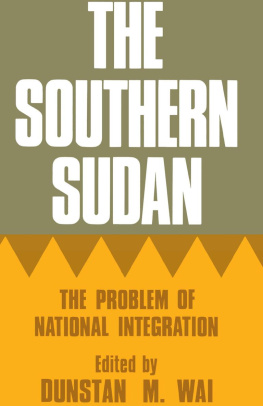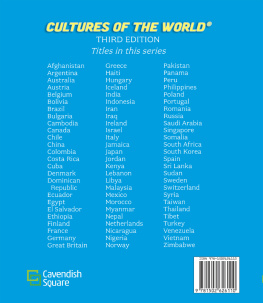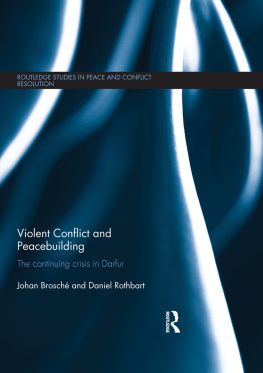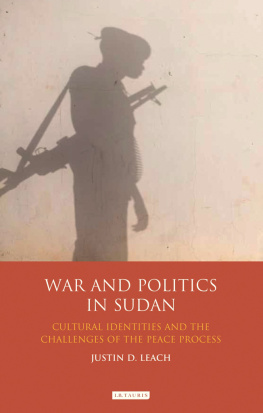
Frontiers of Unity
This book deals with the conflict between Northern and Southern Sudan over the Abyei region and other border areas. This area has historically been a model of peaceful coexistence and cooperation, but, since independence, it has become a point of violent confrontation. Frontiers of Unity provides an essential background to the complexities of the conflict, looking at the factors behind it and calling for the resolution of Africas longest running dispute.
First written in the late 1970s, after the 1972 Addis Ababa Agreement that ended the war in Sudan, the original text has been supplemented by additions and modifications to update its relevance to the current situation in Southern Sudan. In 1983, the continuing dispute in Abyei led to the resumption of hostilities and the eventual escalation into a full-fledged armed struggle under the leadership of the Sudan Peoples Liberation Movement and Army (SPLM/A), which was ended in 2005 by the Comprehensive Peace Agreement, but whose implementation, especially with respect to the conflict over Abyei, remains problematic. Without resolving the cause of Abyei and the other border areas of the Nuba Mountains and Southern Blue Nile, no sustainable peace between the North and South is possible and Abyei remains an explosive flashpoint that could plunge the Sudan back into a war of identities.
This important historical document will be of great relevance to scholars of African-Arab relations, conflict and peace studies and nation building.
Francis M. Deng is Special Advisor of the U.N. Secretary-General on the Prevention of Genocide. He has served as Representative of the Secretary-General on Internally Displaced Persons, as Ambassador of Sudan to Canada, Nordic Countries, and the United States and as Minister of State for Foreign Affairs of Sudan.
Frontiers of Unity
An Experiment in Afro-Arab Cooperation
Francis M. Deng

LONDON AND NEW YORK
First published 2010
by Routledge
2 Park Square, Milton Park, Abingdon, Oxon OX14 4RN
Simultaneously published in the USA and Canada
by Routledge
270 Madison Ave, New York, NY 10016
Routledge is an imprint of the Taylor & Francis Group, an informa business
This edition published in the Taylor & Francis e-Library, 2009.
To purchase your own copy of this or any of Taylor & Francis or Routledges collection of thousands of eBooks please go to www.eBookstore.tandf.co.uk.
2010 Francis M. Deng
All rights reserved. No part of this book may be reprinted or reproduced or
utilised in any form or by any electronic, mechanical, or other means, now
known or hereafter invented, including photocopying and recording, or in
any information storage or retrieval system, without permission in writing
from the publishers.
British Library Cataloguing in Publication Data
A catalogue record for this book is available from the British Library
Library of Congress Cataloging in Publication Data
Deng, Francis Mading, 1938
Frontiers of unity : an experiment in Afro-Arab cooperation / Francis M.
Deng.
p. cm.
Includes bibliographical references and index.
1. Conflict managementSudanAbyei. 2. Abyei (Sudan)Politics and
government. 3. SudanPolitics and government1985- 4. SudanPolitics and
government1956-1985. I. Title.
DT159.6.A24D46 2009
962.4042dc22
2009011325
ISBN 0-203-87005-0 Master e-book ISBN
ISBN 978-0-7103-1352-2 (hbk)
ISBN 978-0-203-87005-1 (ebk)
I [the Abyei Dinka] am the needle and the thread that bind the South and the North together.
Chief Deng Majok
The Abyei Dinka are like the eye, so small but sees so much.
Chief Deng Abot
Abyei is to the Sudan exactly what Sudan is to Africa.
President Jaafar Mohamed Nimeiri
Contents
FRANCIS M. DENG, 1972
|
LESTER E. GORDON AND STEPHEN JOSEPH
|
DAVID C. COLE, RICHARD CASH, WILLIAM R. HUNTINGTON, AND JOHN VILLAUME, FEBRUARY 10, 1977, HARVARD INSTITUTE FOR INTERNATIONAL DEVELOPMENT, HARVARD UNIVERSITY, CAMBRIDGE, MASSACHUSETTS
|
MUHAMMAD AL HASAN MUKHTAR AND ABDALLA BABIKIR, MINISTRY OF AGRICULTURE
|
MOHAMMAD AL HASAN MUKHTAR AND ABDALLA BABKIR, MINISTRY OF AGRICULTURE
|
FRANCIS M. DENG
|
FRANCIS M. DENG, MARCH 2003
|
FRANCIS M. DENG
|
LUKA BIONG DENG, MINISTER OF PRESIDENTIAL AFFAIRS IN THE OFFICE OF THE PRESIDENT, GOVERNMENT OF SOUTHERN SUDAN SPLM CO-AGENT OF THE ABYEI ARBITRATION, JUBA, MAY 2009
|
FRANCIS M. DENG
|
Part One
Framing the context
Updated preface, 2008
This book was written in the 1970s and was about to be published in 1977 by the Institute of African and Asian Studies of the University of Khartoum jointly with Ithaca Press in London, when I stopped its publication because of the political tensions that then prevailed in the Abyei area and my fears that the book might prove a complicating factor in determining the future of the Ngok Dinka of Abyei between the North and the South. Since then, the civil war resumed in 1983, and it is well known that the unresolved situation in Abyei triggered a local rebellion that directly contributed to the resumption of hostilitities by Anyanya Two and the eventual escalation into a full-fledged armed struggle under the leadership of Sudan Peoples Liberation Movement and Sudan Peoples Liberation Army (SPLM/SPLA).
Since then, the cause of Abyei, as indeed that of the other border areas of the Nuba Mountains and Southern Blue Nile, has been fully embraced by the SPLM/SPLA as an integral part of the struggle. These three marginalized areas had become essential items on the agenda for negotiations between the Government of Sudan and the SPLM/SPLA which resulted in the Comprehensive Peace Agreement (CPA) of January 9, 2005; ending a war that had lasted for over twenty years. Although the Government initially resisted including these areas in the negotiations, it became quite obvious that without resolving the problems of these areas, no sustainable peace between the North and South was possible. The CPA included special protocols on these three areas. It is particularly noteworthy that the Ngok Dinka have become fully identified with their southern kith and kin in the struggle and that unlike the postAddis Ababa situation, where both the central and southern regional governments failed to implement the provisions of the Agreement relating to Abyei, and placed the Abyei issue on the back burner of NorthSouth relations, it is now high on the agenda of the SPLM/SPLA. While the implementation of the Abyei Protocol of the CPA is being impeded, even blocked by the Government, and the situation remains explosive, marginalizing the cause of the people of Abyei is no longer an option.
I have decided to publish this book because I believe it provides a historical background that is of interest in itself and also because the complicated perspectives reflected in this background can no longer negatively affect the interest of the Ngok Dinka people. Positions are now drawn and the issues are well defined. Nothing I say can be manipulated anymore to confuse the issues. In any case, the destiny of the people of Abyei is now in the hands of those who have been driven by despair and lack of response to their call for justice to resort to armed stuggle.







